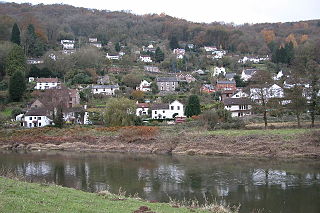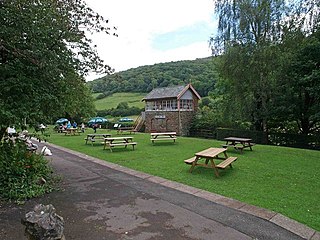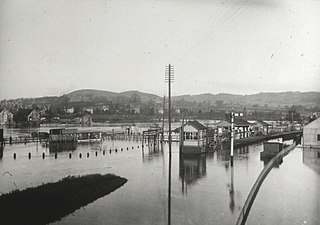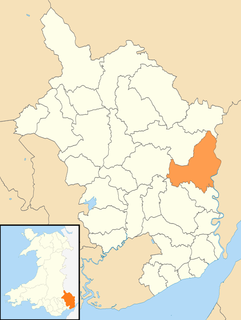
Llandogo is a small village in Monmouthshire, south Wales, between Monmouth and Chepstow in the lower reaches of the Wye Valley AONB, two miles north of Tintern. It is set on a steep hillside overlooking the River Wye and across into the Forest of Dean in Gloucestershire, England. The 2011 census population was 547.

The A466, also known as the Wye Valley Road, is a road from Hereford, England to Chepstow, Wales via Monmouth, Tintern and the Wye Valley.

Coleford Great Western Railway Museum is a railway museum located in Coleford, Gloucestershire, England. The museum was founded in 1988. Based in the former GWR Goods Shed along the Coleford Railway. There was also another station situated at Coleford, it was opened by the Severn and Wye Railway. The Museum traces the history of all the railways in the Forest of Dean, Gloucestershire from the early 19th century when the first plateways were laid, to the 1970s when the Dean Forest Railway was founded. The Museum has information about the Wye Valley Railway, Severn & Wye Railway and Monmouth Troy railway station.

The Wye Valley Railway was a standard gauge railway that ran for nearly 15 miles (24 km) along the Lower Wye Valley between the towns of Chepstow and Monmouth, crossing several times between Wales and England. Opened on 1 November 1876, it was leased to, and worked by, the Great Western Railway (GWR), before being fully absorbed by the GWR in 1905.

Monmouth Troy was one of the two former railway stations at Monmouth. It was built in 1857 by the Coleford, Monmouth, Usk and Pontypool Railway and was used by several other branch lines as the local rail network expanded. The station closed in January 1964 following the closure of the last two lines to the station, the Wye Valley Railway and the Ross and Monmouth Railway.
Tidenham Station was the station for the village of Tidenham on the former Wye Valley Railway. It was opened in 1876 during the construction of the line and closed on 5 January 1959 following the closure of the line to passenger services. The next station on the line was Netherhope Halt.

Tintern railway station served the village of Tintern on the Wye Valley Railway. It was opened in 1876 and closed for passengers in 1959 and freight in 1964, when the line was closed completely. It was the second largest station on the line, the most substantial being Monmouth Troy railway station.
Brockweir Halt was a request stop on the former Wye Valley Railway. It was opened to the public on 19 August 1929. It closed in 1959 when passenger services were withdrawn from the line. It was situated just north of Brockweir bridge. Nothing now remains of the trackbed because of the realignment of the A466.
St Briavels Station was a station along the Wye Valley Railway. It was built in 1876 during the construction of the line on the Monmouthshire side of the River Wye at Bigsweir, and was intended to serve the nearby villages of St Briavels, across the river in the Forest of Dean, and Llandogo, which is further down the Wye Valley. It was closed on 5 January 1959 when the line was closed to passenger services.
Whitebrook Halt was a request stop on the former Wye Valley Railway. It was built in 1927 to serve the village of Whitebrook and opened in February that year. It was closed in 1959 when passenger services were withdrawn from the Wye Valley Railway. The station came too late to make full use out of the village's industry. Whitebrook had once been home to three paper mills. However, paper making ceased in Whitebrook in the early 1880s, only four years after the line opened in 1876. The halt was not built until long after the closure of the paper mills.
Redbrook on Wye railway station was a station serving the village of Redbrook on the now disused Wye Valley Railway. It was opened on 1 November 1876 with the rest of the line and remained open for 83 years, it closed in 1959. The sidings and passing loop remained open until late 1961 to serve the Tinplate Works in the village.

Penallt Viaduct is a viaduct that formerly carried the Wye Valley Railway over the River Wye, which at this location forms the border between England (Gloucestershire) and Wales (Monmouthshire). The 14-mile (23 km) Wye Valley Railway opened on 1 November 1876.

Monmouth Mayhill railway station is a disused railway station on the Ross and Monmouth Railway which was opened in 1873 and closed in 1959. It was one of two stations that served the town of Monmouth, Wales and was situated on the opposite bank of the river River Wye from Monmouth. It was the initial terminus of the line, but the line was extended across the River Wye to the junction station of Monmouth Troy in 1874 with the construction of the Duke of Beaufort Bridge.
Lydbrook Junction railway station is a disused railway station in England opened by the Ross and Monmouth Railway in 1873, it remained open for 91 years until 1964 when the line finally closed to freight, though passenger services ceased in 1959. The station was constructed in the hamlet of Stowfield approximately half a mile from Lydbrook and its viaduct on the Severn and Wye Railway. It was located approximately 4 miles and 34 chains along the railway from Ross-on-Wye station. In 1874 the Severn and Wye Railway opened a branch from Serridge Junction and Cinderford, passenger services commenced in 1875. All passenger trains along the S&W branch were withdrawn from 1929.
Monmouth Troy Goods Yard was a large goods yard near Monmouth Troy railway station in Monmouth, Wales. It was opened in 1857 by the Coleford, Monmouth, Usk and Pontypool Railway at the same time as the station. As other railways reached Monmouth Troy the goods yard grew in importance. At its height, the goods yard was used by the Wye Valley Railway, Coleford Railway, Ross and Monmouth Railway as well as the Coleford, Monmouth, Usk and Pontypool Railway. The goods yard closed in 1964 when the last two railways, the former Wye Valley Railway and Ross and Monmouth Railway, closed. The non-rail depot remained open until October 1964.
Chepstow East railway station was a temporary station on the South Wales Railway. It was on the opposite bank of the River Wye from Chepstow and was only used for a few months until the river was crossed by a railway bridge. This was about a mile from Chepstow railway station, at the road bridge close to the future junction of the Wye Valley line. It was opened on 19 September 1851 and served as a temporary station while the Chepstow railway bridge was being constructed across the river to link up with the rest of the line. It closed on 19 July 1852, the day that the bridge over the Wye was opened.

Tintern Quarry was a quarry in the Forest of Dean, Gloucestershire, England. It was served by the Wye Valley Railway from 1876 until it closed in 1981. The quarry was on the opposite side of the River Wye from the village of Tintern.
Tutshill for Beachley Halt was a request stop on the South Wales Railway and Wye Valley Railway. It was opened on 9 July 1934, and was intended to serve the nearby village of Tutshill. However, though the station was situated a short distance from the junction of the Wye Valley Railway and was still on the main line, the only trains which served the small halt were from the Wye Valley Railway and when the line closed on 5 January 1959, the stop closed with it.

Beacon Hill is the highest hill in eastern Monmouthshire, South Wales. It is located 0.6 miles (0.97 km) due east of the village of Trellech, and 1 mile (1.6 km) north-west of Llandogo. Its crowning point at 306m / 1006 ft above sea level is marked by an Ordnance Survey triangulation pillar. The summit, eastern slopes and uppermost western slopes are owned by Natural Resources Wales which manages the area not only for timber production but for recreation also.

Trellech United is a community and electoral ward in the county of Monmouthshire, Wales. It lies south of the county town of Monmouth next to the Wales-England border.









